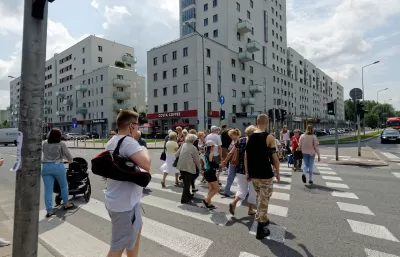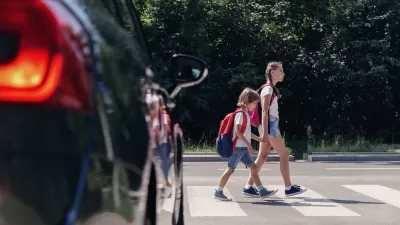Pedestrians are often blamed first for accidents, but they have few choices when the infrastructure is lacking, a new study shows.

Michael Smith, a University of Illinois graduate student, collected video at intersections on a road in Rockford, Illinois, to understand better how pedestrians interact with the built environment. Often pedestrians are blamed for accidents, with the assumption being that they were jaywalking or not paying attention to their surroundings.
"But Smith’s videos found pedestrians’ behavior is influenced a lot by the environment: They’re more likely engage in risky behavior — like walking or rolling in the street or crossing mid-block — when the pedestrian infrastructure is incomplete or lacking," reports Angie Schmitt.
At one intersection, Smith repeatedly saw examples of people backtracking and going into the street because there was not an ADA-compliant ramp at the corner, even though the location was near a housing development for older people. He also noticed that people waiting for buses at a stop without a bench or shelter would wait on the other side of the street at a shopping center and then dart across when the bus came.
"People were adapting their behavior to the conditions, often in ways that put them at risk," notes Schmitt. Smith’s recommendations include a decrease in the speed limit, enhanced crosswalks, and leading pedestrian intervals at signaled intersections.
FULL STORY: Research Explains Why Pedestrians ‘Break the Rules’

Alabama: Trump Terminates Settlements for Black Communities Harmed By Raw Sewage
Trump deemed the landmark civil rights agreement “illegal DEI and environmental justice policy.”

Study: Maui’s Plan to Convert Vacation Rentals to Long-Term Housing Could Cause Nearly $1 Billion Economic Loss
The plan would reduce visitor accommodation by 25% resulting in 1,900 jobs lost.

Planetizen Federal Action Tracker
A weekly monitor of how Trump’s orders and actions are impacting planners and planning in America.

Wind Energy on the Rise Despite Federal Policy Reversal
The Trump administration is revoking federal support for renewable energy, but demand for new projects continues unabated.

Passengers Flock to Caltrain After Electrification
The new electric trains are running faster and more reliably, leading to strong ridership growth on the Bay Area rail system.

Texas Churches Rally Behind ‘Yes in God’s Back Yard’ Legislation
Religious leaders want the state to reduce zoning regulations to streamline leasing church-owned land to housing developers.
Urban Design for Planners 1: Software Tools
This six-course series explores essential urban design concepts using open source software and equips planners with the tools they need to participate fully in the urban design process.
Planning for Universal Design
Learn the tools for implementing Universal Design in planning regulations.
Caltrans
Smith Gee Studio
Institute for Housing and Urban Development Studies (IHS)
City of Grandview
Harvard GSD Executive Education
Toledo-Lucas County Plan Commissions
Salt Lake City
NYU Wagner Graduate School of Public Service





























